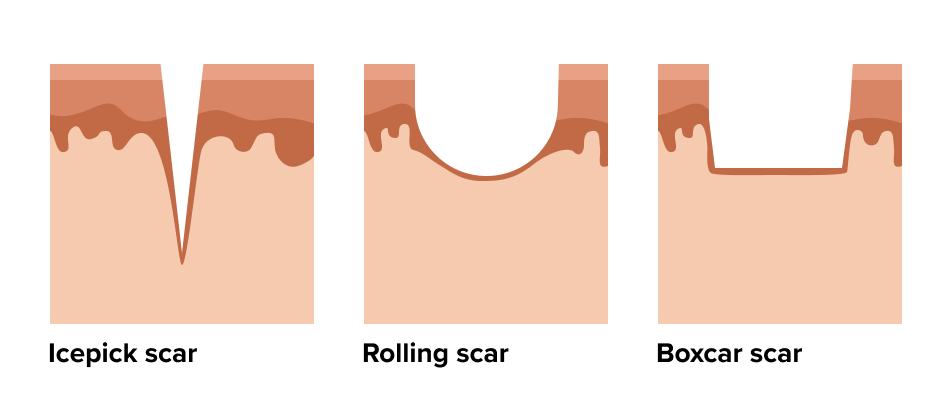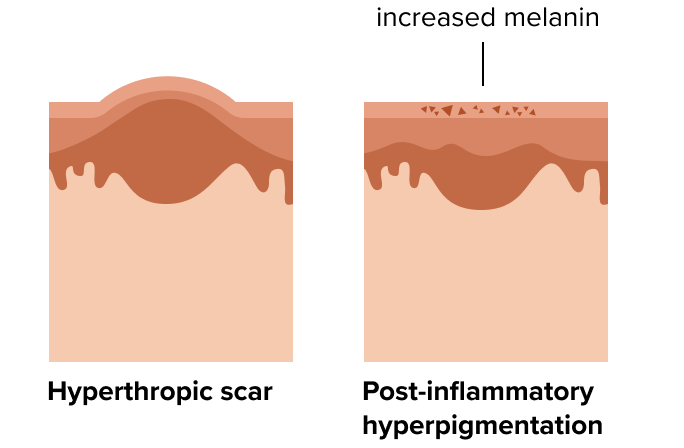Acne scarring – what is it and how to treat it?
Overview
Acne scarring is a common and frustrating complication of acne but the good news is it can be treated. The type of treatment depends on the type of scarring and a key element is to treat any remaining acne before embarking on more invasive scar treatment.
Who gets acne scars?
Acne scarring is unfortunately very common and up to 30% of people with acne will develop scarring. Who goes on to develop scarring depends on the type of spots you suffer from — with nodular and cystic the acne lesions most likely to cause scarring. However, scarring can occur with any type of acne, especially if picked or scratched.
Other factors, such as how long you’ve had acne for, as well as genetics have been found to be important risk factors. This is why the most important strategy for dealing with acne scarring initially is to get your spots under control. Acne scarring can also have a profound impact on mental health making it important to address early.
What are the different types of acne scars?
There are two main groups of scarring:
- Scarring where tissue is lost, leading to indentations or depressions of the skin (called atrophic scarring).
- Scarring that causes scar tissue formation, leading to raised scars on the skin (called hypertrophic or keloid scarring).
These types of scarring can be further divided into other categories of acne scars.
Indentations or depressions:
- Ice pick scars – these are small, and are typically narrow but deep scars.
- Box scars – these are broader than ice pick scars, but still have sharp borders and are deep.
- Rolling scars – these are broader scars but with sloping edges.
- Atrophic scars – these shallower than other indentation scars and thin.

Hypertrophic scarring and keloid scarring:
- Hypertrophic scarring and keloid scarring – hypertrophic scarring appears as thickened elevated scars caused by excessive scar tissue formation. If you run your finger over the scar it feels raised compared to the rest of the skin.
- Keloid scarring – this is one step further than hypertrophic scarring and appears as lumps or nodules made from scar tissue. It is particularly common over the back, chest, shoulders and lower face; it is more often seen in skin of colour.
How can acne scars be treated?
First – treat the acne.
It’s very important to treat the acne first, to prevent further skin damage, before treating the scarring directly afterward.
Second – treat the acne scars.
It’s important to understand that treating acne scarring can be difficult and it takes time to improve. The success of treatment will depend on the type of scarring that you have and usually topical treatments will only benefit mild scarring. For more extensive scarring, additional more invasive treatments are likely to be more beneficial.
The end results are variable and it’s important to realise treatment is not perfect. Although it can significantly improve, skin will not revert to the way it looked before breakouts.
What are the best topical treatments for acne scarring?
Retinoids/Tretinoin:
The prescription retinoid Tretinoin is a great treatment and starting point for any type of scarring. Not only is Tretinoin an effective acne treatment, it also treats any hyperpigmentation that occurs due to acne. Retinoids also stimulate collagen production and reduce inflammation, thereby helping the treatment of scarring. It’s important to note that results will take months.
As there is no evidence for over-the-counter retinoids effectively treating acne scarring, it is best to opt for a prescription treatment immediately.
Sunscreen:
Sunscreen is an important part of the treatment of acne and acne scarring. UV exposure can darken scars and make them more pronounced as well as contribute to further inflammation which can cause breakouts and worsen scarring. We therefore recommend that you wear a broad spectrum SPF of at least 30 (ideally with a visible light filter) and that you incorporate it into your daily morning skincare routine.
What other treatments are available for acne scarring?
There are other treatments available, but whether they will be effective will depend on what type of scarring you have, the extent, and your skin type. But scarring cannot be treated with just one session and often treatments have to be repeated and maintained over the years.
- Microdermabrasion
- Microneedling +/- PRP
- Laser resurfacing
- Fillers
- Subcision
- Excision of larger scars
How can hypertrophic or keloid scars be treated?
Hypertrophic and keloid scars should be treated differently to indentation acne scars, and always under the supervision of a dermatologist. The available treatments include:
- Topical steroids
- Silicone gel dressings
- Steroid injections +/- surgery
- Radiotherapy
Scarring or pigmentation?
Colour changes in the skin as a result of acne are often confused with acne scarring, but are actually very different. These occur without any structural changes to the skin and are colour changes only. They can be broadly divided into three types.
- Hyperpigmentation – these are dark marks caused by an increase in the amount of melanin produced by the skin as a consequence of inflammation in acne. These appear as first red, then brown or dark brown spots over the site of previous acne. The key difference between hyperpigmentation and scarring is that darker spots are not associated with a change in the structure of the skin, the skin will also feel flat and lacks the usual indentation seen in true scarring.

- Post-inflammatory erythema – this refers to the redness seen after active acne lesions resolve. The colour ranges from red to purple and the area feels flat when you run your finger across it.
- Post-inflammatory hypopigmentation – these are white marks instead of dark marks and again the area feels flat.
